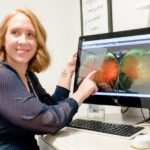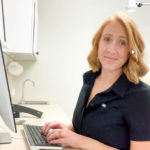
Dr. Hornberger shows patients wide-field image results, like this, explaining both diagnoses and the need for care to make sure eyes stay healthy.
By Samantha Hornberger, OD
August 31, 2022
Educating patients in the exam room encourages compliance in treatment plans, and makes it more likely patients will return for recommended follow-up care. There is also a positive financial impact to educating patients about their eye health and vision needs.
In addition to purchasing recommended products, patients are more likely to continue to see a provider who educates them, returning each year for the preventative care benefits of an annual exam.
Patient Education Begins With Asking Right Questions
My first question to each patient is, “What brings you in to see me today, what can I help you with?” Then, I try my best to just listen, without interruption, until they are done telling me why they are in my office. That is not easy! By just listening, though, I get a picture of what is most important to them for their visit and can tailor the education I give them to the information they want. Occasionally, there are things that become apparent during the visit that are important to address, but I find that when I start from a stance of what is important from the patient’s perspective, they are more receptive to the things that I need to educate them about.
Part of education can also be cultivating curiosity. For example, if I see that a patient has a particular symptom, caused by a particular issue, and can demonstrate that in some way, they get curious about what is causing it and how to fix it. If they are curious, they are primed for the solutions I am going to offer them.
When I complete an exam I let patients know that they are welcome to text or call the office with additional questions. Often, my team can address those questions without my input, but they will pass questions along to me that need my attention. My team also carries on the conversation about topics like daily disposable contacts, myopia control, dry eye treatments and neurolens treatment. They have all experienced those treatments and recommendations themselves, so they can be a great source of social proof.
Make Patients an Active Partner in Their Own Care
Patients who are educated can be a more active partner in their own care. Patient care, when done well, is a partnership between doctor and patient. As doctors, we can make all the recommendations for treatments we want, but if patients don’t have an understanding of their disease or condition, they are less likely to heed those recommendations. In educating patients I am inviting them to actively participate in their care and build trust in my ability to manage it.
Questions like, “What can I help you with today?” and “Does that bother you?” help get the patient to be active in their care. The things that they tell me are the things that they want solutions to, and when I give them those solutions, they are more likely to listen and accept my recommendations.
Use Advanced Instrumentation to Further Patient Education
I do wide-field imaging during every comprehensive exam. I found these images to be invaluable in educating patients who have ocular disease, but also in demonstrating to patients why we recommend that they be seen for annual eye health exams even without noticeable changes in vision.
When patients are able to see all the “moving parts” to vision, and I take the time to explain what I am examining them for, they have a deeper understanding of the miracle of vision and are more likely to prioritize preventative exams. This has a financial benefit, as well, since we charge patients for wide-field imaging on a screening basis. The simple act of doing wide-field imaging screenings on every patient in our office yields about $55,000 per year in revenue.
Other Articles to Explore
During exams I am reviewing and educating on wide-field imaging, OCT findings, visual field results or assessment with the neurolens device. I also love having a model of healthy and unhealthy lids and lashes to show patients experiencing dry eye symptoms, or better yet, images of the patient’s own lids and lashes, in addition to meibography, to illustrate why they feel the way they do. My eye model is always handy, as well, to explain conditions like vitreous detachment and why follow-up care is important, or to explain how cataracts affect vision and why they may need surgery.
I have resources available on my website, and think that is definitely important, but the most important education happens in the exam room.
Grow Specialty Services
I find that education is especially important to cultivating specialty services. For example, I noticed that our success with neurolens is directly correlated to the education I give in the exam room. When I am doing a good job giving simple education on the symptoms relieved by treatment with the lenses, and demonstrating that to my patients, we have a much higher acceptance rate. This is great for patients, as they get relief from their symptoms, and it’s great for the financial health of our practice.
Explain What Patients Need to Know, But Don’t Overwhelm Them
I am always making changes to how I present information to the patient. I am a teacher at heart, so I have to be careful not to go into so much detail that I overwhelm the patient. Over the years I have honed my education on wide-field imaging to take only about 60 seconds, but I usually take more time when reviewing OCT or visual fields. I am working to make my education as impactful as possible, without overwhelming the patient, or falling behind in clinic.
 Samantha Hornberger, OD, is the owner of Bright Family Eye Care in Lawrenceburg, Ind. To contact her: doctorsam@brightfamilyeyecare.com
Samantha Hornberger, OD, is the owner of Bright Family Eye Care in Lawrenceburg, Ind. To contact her: doctorsam@brightfamilyeyecare.com

























